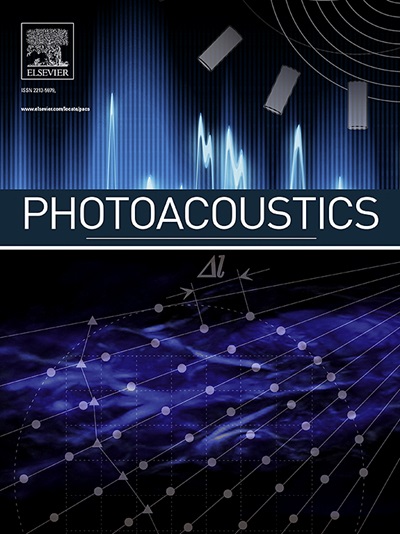用于研究阻力血管机械转导反应的光声显微镜
IF 7.1
1区 医学
Q1 ENGINEERING, BIOMEDICAL
引用次数: 0
摘要
心血管疾病呈上升趋势,对全球健康构成重大挑战。能够检测血管网络变化的方法的发展对于心血管疾病(包括外周动脉疾病、中风和高血压)的早期诊断和治疗至关重要。在这里,我们使用光声显微镜(PAM),一种非侵入性成像技术,来监测内皮细胞中机械敏感通道Piezo1 (Piezo1 EC-KO)缺乏的慢性高血压小鼠皮肤血管内的形态学变化。我们表明,与对照小鼠(Piezo1 flox/flox)相比,Piezo1 EC-KO小鼠的特征是由于阻力小动脉的血管收缩而导致组织灌注较差。我们还展示了给药药物对piezo1缺陷小鼠和对照小鼠皮肤血管舒张的影响,确定了两组之间的数量差异。这些结果促进了我们对血管力学动力学的理解,并为高血压疾病的靶向治疗提供了潜在的启示。本文章由计算机程序翻译,如有差异,请以英文原文为准。
Photoacoustic microscopy for studying mechano-transduction response in resistance vessels
Cardiovascular diseases are on the rise, presenting a significant global health challenge. The development of methods enabling the detection of alterations in vascular networks is critical for the early diagnosis and treatment of cardiovascular diseases, including peripheral arterial disease, stroke, and hypertension. Here, we use photoacoustic microscopy (PAM), a non-invasive imaging technique, to monitor morphological changes within the skin vessels of chronically hypertensive mice deficient in the mechanosensitive channel Piezo1 in endothelial cells (Piezo1 EC-KO). We show that, compared to control mice (Piezo1 flox/flox), Piezo1 EC-KO mice are characterized by poorer tissue perfusion due to a vasoconstriction of resistance arterioles. We also show the effect of administration of pharmacological agents on vessel vasodilation in the skin of Piezo1-deficient mice and control mice, identifying quantitative differences between the two groups. These results advance our understanding of vascular mechanodynamics and offer potential implications for developing targeted treatments for hypertensive disorders.
求助全文
通过发布文献求助,成功后即可免费获取论文全文。
去求助
来源期刊

Photoacoustics
Physics and Astronomy-Atomic and Molecular Physics, and Optics
CiteScore
11.40
自引率
16.50%
发文量
96
审稿时长
53 days
期刊介绍:
The open access Photoacoustics journal (PACS) aims to publish original research and review contributions in the field of photoacoustics-optoacoustics-thermoacoustics. This field utilizes acoustical and ultrasonic phenomena excited by electromagnetic radiation for the detection, visualization, and characterization of various materials and biological tissues, including living organisms.
Recent advancements in laser technologies, ultrasound detection approaches, inverse theory, and fast reconstruction algorithms have greatly supported the rapid progress in this field. The unique contrast provided by molecular absorption in photoacoustic-optoacoustic-thermoacoustic methods has allowed for addressing unmet biological and medical needs such as pre-clinical research, clinical imaging of vasculature, tissue and disease physiology, drug efficacy, surgery guidance, and therapy monitoring.
Applications of this field encompass a wide range of medical imaging and sensing applications, including cancer, vascular diseases, brain neurophysiology, ophthalmology, and diabetes. Moreover, photoacoustics-optoacoustics-thermoacoustics is a multidisciplinary field, with contributions from chemistry and nanotechnology, where novel materials such as biodegradable nanoparticles, organic dyes, targeted agents, theranostic probes, and genetically expressed markers are being actively developed.
These advanced materials have significantly improved the signal-to-noise ratio and tissue contrast in photoacoustic methods.
 求助内容:
求助内容: 应助结果提醒方式:
应助结果提醒方式:


